Rewriting Bronze Age chronology? – Conference on the 115-year-old Reinecke system
One of the most important goals of our work is to develop a more accurate absolute chronology within the thousand-year-long period of the Hungarian Middle Bronze Age (2500-1500 BC) with the help of new AMS 14C dates. In relation to an international conference held between 12th-15th June 2017 in Křtiny, Czech Republic, in this article we give an overview on the formation of the current Central European Bronze Age chronology and focus on issues that Bronze Age researchers had to face in recent decades.
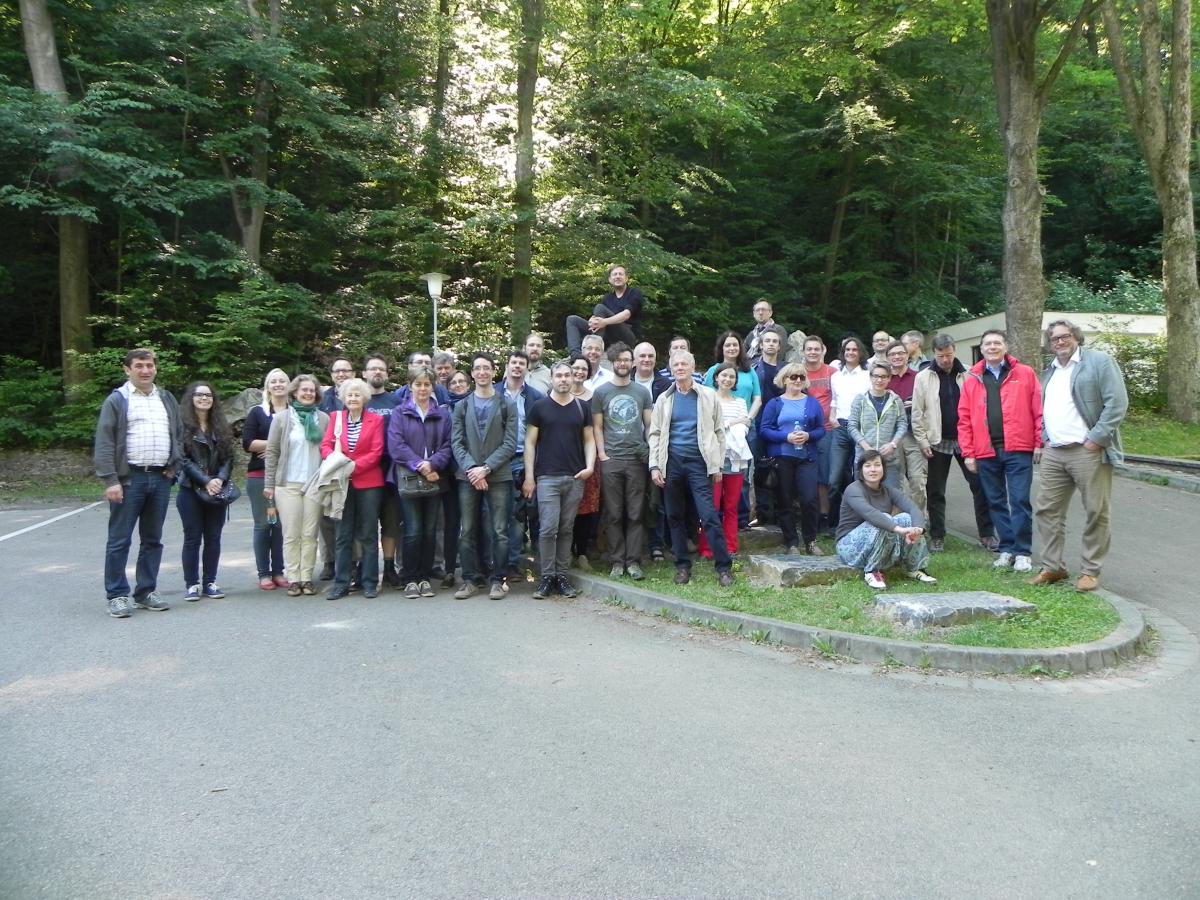
Participants of the meeting (Photo: Michal Ernée)
The beginnings
The basic relative chronological system of the Central European Bronze Age was established by Paul Reinecke (1872–1958). His study was published 115 years ago, in 1902. Based on the typological evaluation of bronze artefacts, he divided the Bronze Age into four main phases: Bronzezeit (Br) A-D Period, supplemented by two additional phases (Hallstatt A-B Period) (Reinecke 1902). The system was later revised and further elaborated. Walter Ruckdeschel gave a more detailed division of the Early Bronze Age (Reinecke Br A1-A2 Period), based on the typochronology of pin types found in the territory of present-day Germany (Ruckdeschel 1979).
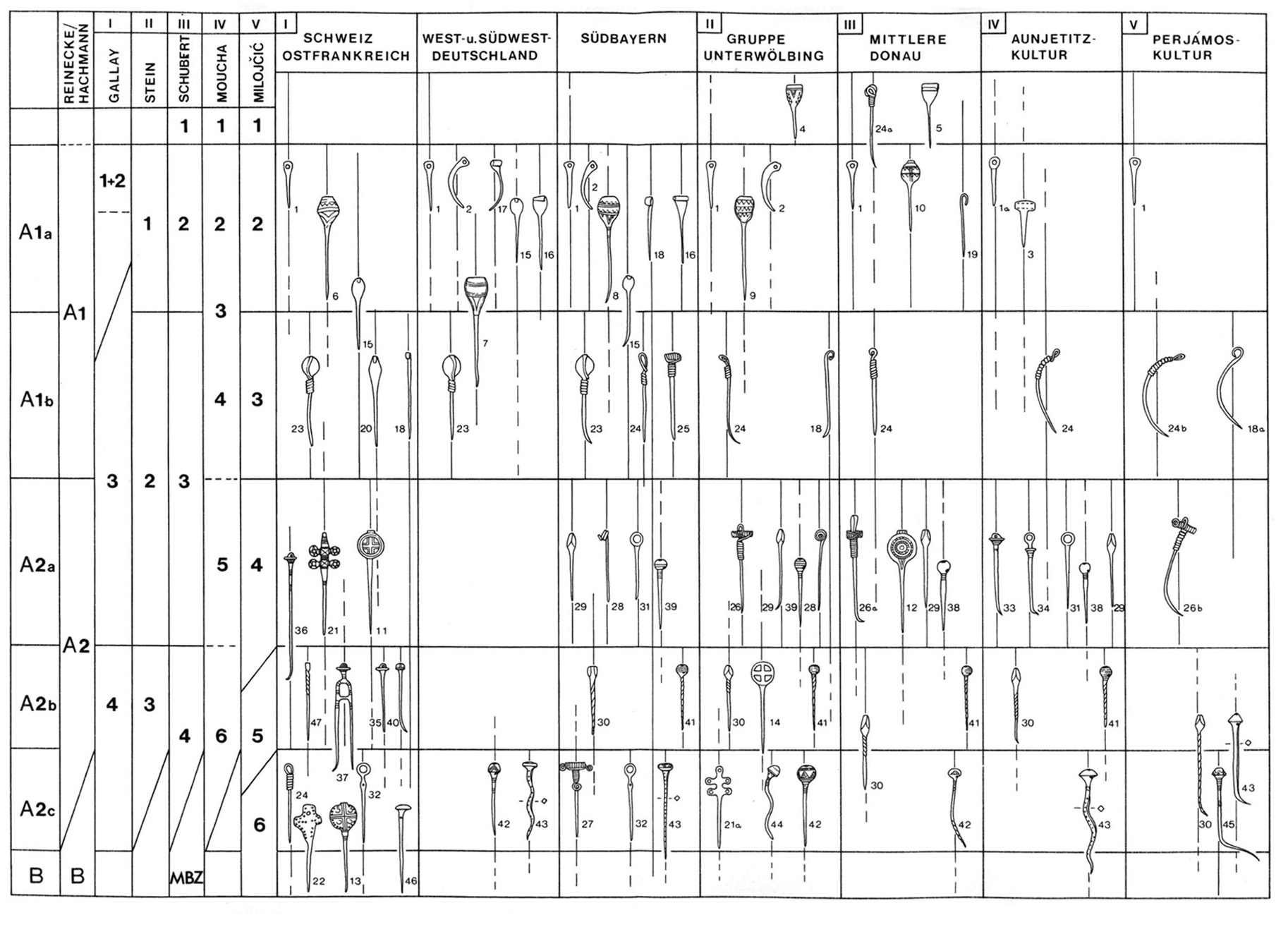
Chronological sequence of bronze pins by Ruckdeschel (1979)
Due to many further refinements and additions, the chronological system developed by Paul Reinecke has evolved over the last decades. As part of this, for example, François Bertemes and Volker Heyd proposed the introduction of A0 Period preceding the original A1 Period (Bertemes-Heyd 2002).
What about the Carpathian Basin?
The sequence established by Reinecke played a significant role in terms of the Bronze Age chronology in Hungary, as Amália Mozsolics has adapted it to develop her own system for the Hungarian Early and Middle Bronze Age (Mozsolics 1967). Slightly earlier however, Ferenc Tompa based the Hungarian Bronze Age chronology on the stratigraphy of a characteristic multilayer tell-settlement, called Laposhalom near Tószeg (Tompa 1936).
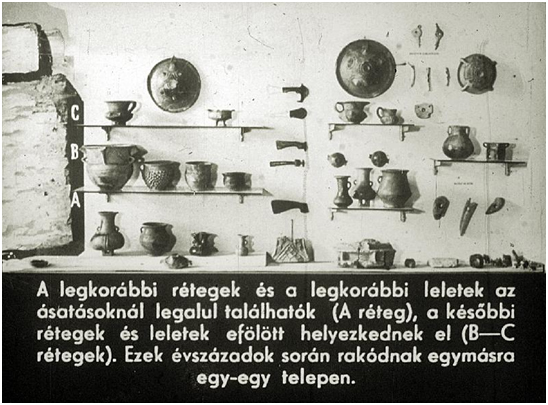
“During the excavations, the earliest layers and the earliest finds are found at the bottom (Layer A), later layers and finds are located above (Layers B and C). The finds and layers have been deposited over centuries on each site.” – The layers and finds from Tószeg (after Fülep 1956)
During the elaboration of the Hungarian Early and Middle Bronze Age chronology that is commonly used even nowadays, István Bóna relied only little on the above-mentioned Central European chronological system. He considered the close relations of the Carpathian Basin to Southeast Europe and the Balkans as well as the timeline suggested by the layers of the tell-settlements to be more important. He briefly and unequivocally commented on Reinecke’s chronology:
„A/1 Period of Reinecke’s Central European chronology is equal to Middle Bronze Age 1 in the Middle Danube Basin.” (Bóna 1960, Bóna 1961, Bóna 1975, 9-10, 25-26, 247, Kemenczei 1989, 93)
Accordingly, the Hungarian Middle Bronze Age 1 = Br A1, Middle Bronze Age 2 = Br A2. It means that our Early Bronze Age completely precedes Central European Early Bronze Age cultures dated to the Br A Period of the Reinecke chronology. This is how the Hungarian chronology, that is shifted with almost a complete period from the Middle European Bronze Age chronology, evolved. This dichotomy led to a decade-long debate between German, Austrian, Slovakian, Romanian and Yugoslavian researchers using the Reinecke system and the Hungarian research (Hänsel 1968, Abb. 2). This in part led to the complete ignorance of Reinecke’s chronology in Hungary as well.
Later, in the 1980s, Nándor Kalicz and Rózsa Kalicz-Schreiber called attention to the occurence of metal objects at the end of the 3rd phase of the Hungarian Early Bronze Age that can be dated to Br A1 Period (Kalicz 1982, 129, Kalicz-Schreiber 1984, 194). For this reason, over the past two decades, it has become necessary to review the parallelization of the Hungarian Bronze Age periodization and the Reinecke chronology used in the neighbouring countries (Kulcsár–V. Szabó 1997, 154; Kiss 2002; Kiss et al. 2015; P. Fischl et al. 2015).
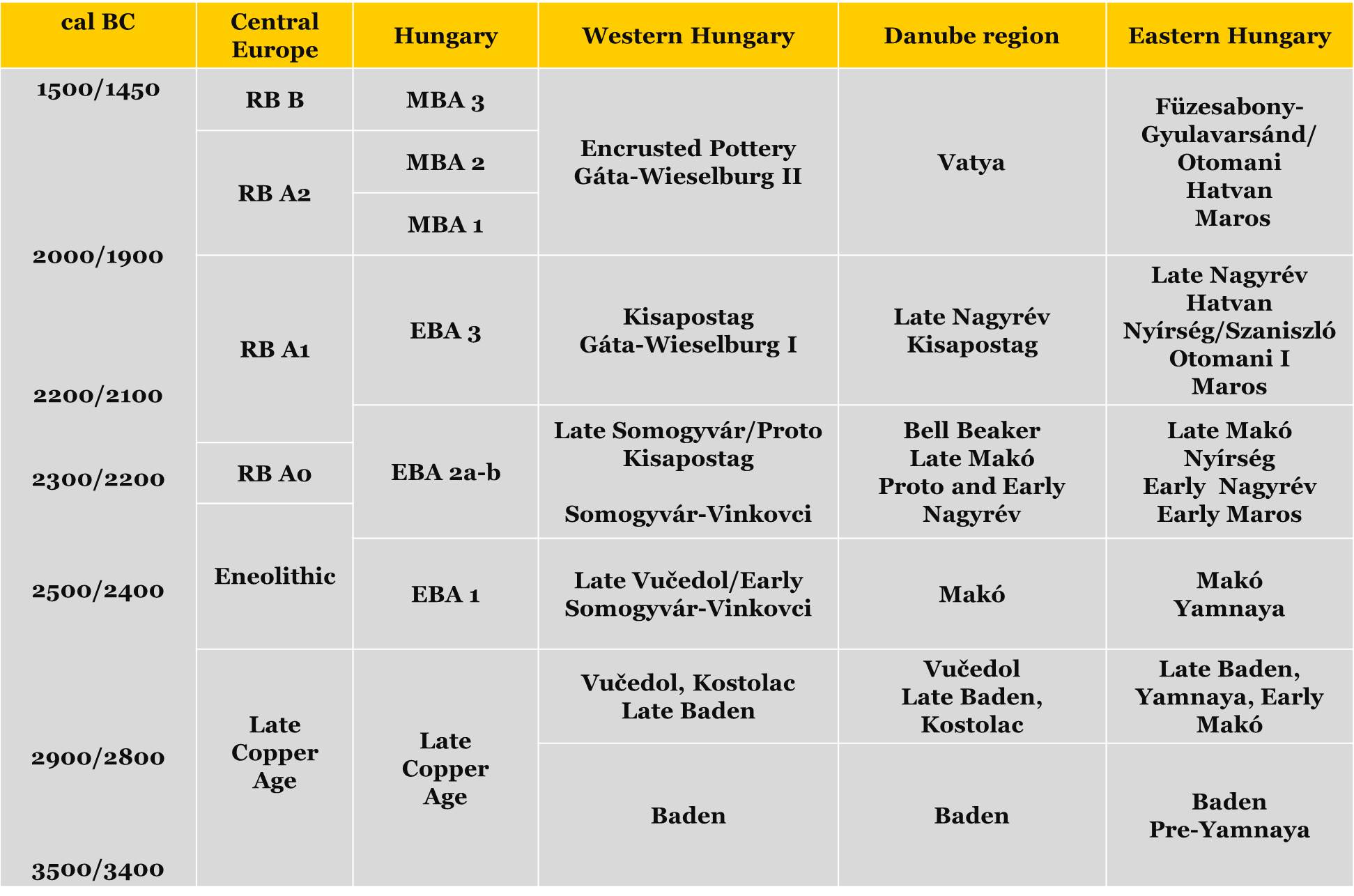
The recent summary of the Hungarian results of the era’s research (P. Fischl et al. 2015, Fig 1)
Relative chronology and absolute dates
Even the earliest works tried to place Bronze Age on the absolute time scale: the beginning of the era was set to 2000 BC, while its end was placed around 900 BC (Tompa 1936). Contemporaneous dating difficulties, however, are well reflected by the thoughts of Amália Mozsolics:
“We have to admit that we do not have accurate data on which we can offer – so popular – exact dates to museum visitors. (…) Hungarian researchers generally preserve in the opinion that Bronze Age started in 2000 BC. These numbers can only be classified as estimates and not as irreducible scientific data. “(Mozsolics 1943, 11)
In the 1980s and 1990s, the gradually increasing number of 14C and dendrochronological data enabled archaeologist to more accurately place Reinecke’s relative chronological system on the absolute time scale. The classical Aunjetitz period (Reinecke Br A2) could be dated around 1950-1900 BC on the basis of the radiocarbon dating of wooden remains from the Early Bronze Age princely grave of Leubingen, while the tree ring dating of the same samples resulted exactly in 1942 BC (Meller 2014, Abb. 18).
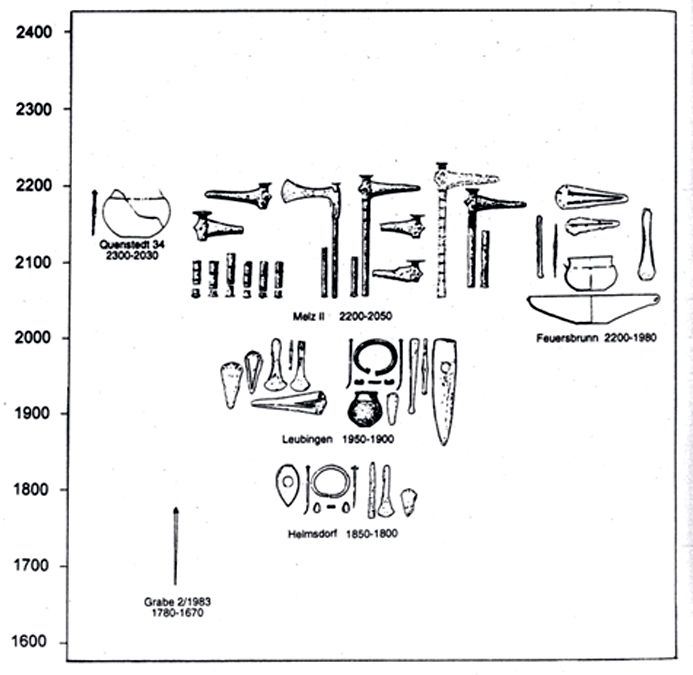
The burials and hoards of the Aunjetitz culture with absolute dates (following Müller 1999)
The more appropriate dating of the elder phases of the Central European Early Bronze Age (Br A1) was based on data from the cemetery of Singen (Becker-Krause-Kromer 1989, 428-430, Tab. 4-5). According to these results, Br A1 can be placed between 2200 and 2000 BC, Br A2 is mostly between 2000 and 1600/1500 BC, while Br B-C is between 1600/1500-1300/1250 BC (Forenbaher 1993, 252, Gerloff 1993, Abb. 8-10, Krause 1996, 76 -81, Abb. 1, Abb. 5; Gerloff 2005).
In 2015, however, Philipp Stockhammer and colleagues suggested rewriting the absolute dating of the Reinecke chronology after re-dating the Singen cemetery and by adding a hundred of new AMS radiocarbon data from Southeast Germany. According to their opinion, the Br A1 Period began in 2150 instead of 2200 BC, while the Br B Period began in 1700 instead of 1600 BC (Stockhammer et al., 2015).
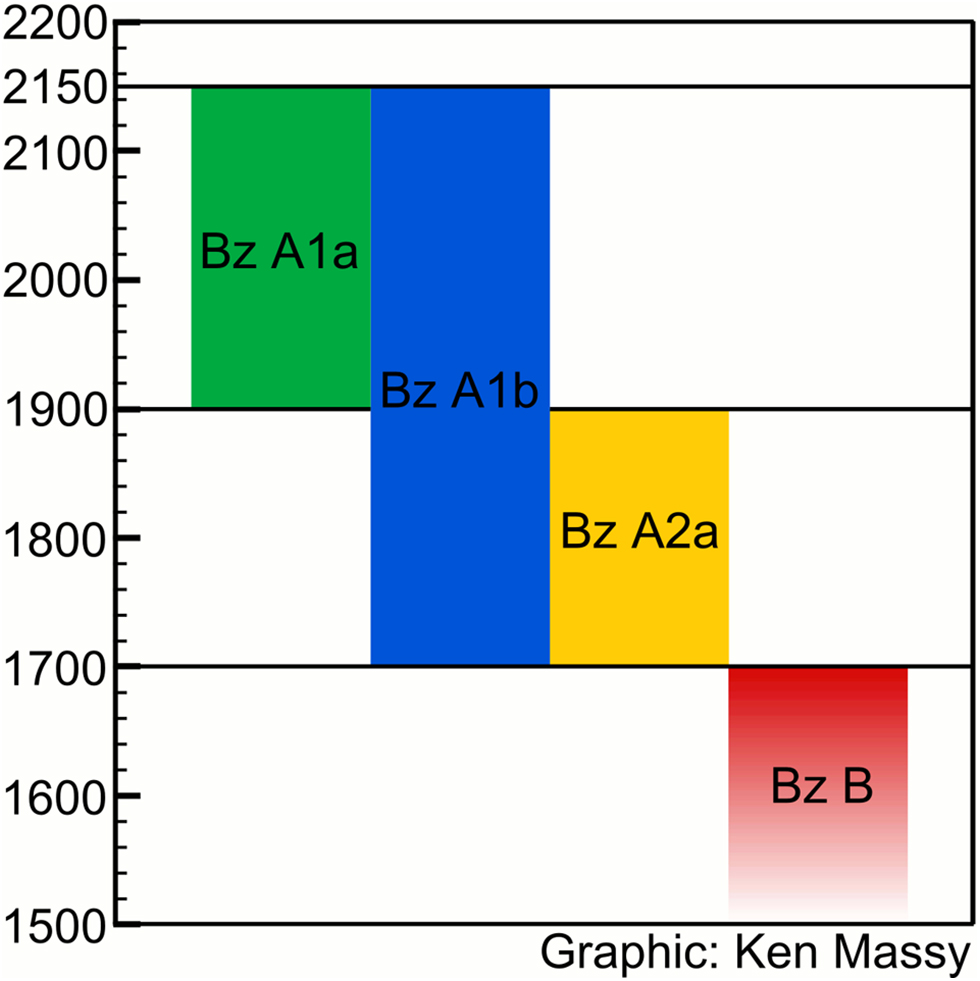
The modified Central European Early and Middle Bronze Age chronology as proposed by Stockhammer et al. (2015)
Old questions, new answers?
The organizers of the conference held in Křtiny, Czech Republic, sponsored by the Humboldt Foundation, aimed at assessing and summarizing the latest research situation through invited speakers from today’s Germany, Austria, Czech Republic, Slovakia, Poland, Hungary and Romania (see the abstract volume of the conference).
At the conference, our ’Momentum’ Mobility Research Group was able to outline the current possibilities of synchronizing the Central European and Hungarian chronologies through the review of more than 50 new AMS 14C data available.
Klára P. Fischl, Viktória Kiss, Gabriella Kulcsár
Hungarian Early and Middle Bronze Age chronology revisited
The chronological system established by Paul Reinecke played a significant role in working out the relative chronological classification for the Hungarian Bronze Age. Amália Mozsolics relied on the original Reinecke scheme and the slightly modified version of it by Holste-Willvonseder while setting up her own classification for this time period. However, the relative chronological system which is currently being used for the Early and Middle Bronze Age by the majority of Hungarian scholars is based on István Bóna’s chronological scheme. Although Bóna’s chronology is still regarded as the “lingua franca”, there have been attempts in the last decade to synchronise Bóna’s relative chronological classification of the Hungarian Bronze Age with the broader Reinecke scheme. In this presentation we would like to compare the two chronological systems and to highlight certain common chronological cornerstones, aided by the most recent 14C dates from the Carpathian Basin.
Recommended citation format: URL: https://mobilitas.ri.abtk.hu/?media=ujrairni-bronzkor-idorendjet-konferencia-115-eves-reinecke-kronologiarol (Accessed day, month, year)
References
Becker, B.–Krause, R.–Kromer, B.: Zur absoluten Chronologie der frühen Bronzezeit. Germania 67 (1989) 421–442.
Bertemes, F.–Heyd, V.: Der Übergang Kupferzeit/Frühbronzezeit am Nordwestrand des Karpatenbeckens – Kulturgeschichtliche und paläometallurgische Betrachtungen. The Transition Copper Age/Early Bronze Age at the North-Western Edge of the Carpathian Basin – Culture-Historical and and Palaeometallurgical Considerations. In: Bartelheim, M., Krause, R., Pernicka, E.: Die Anfänge der Metallurgie in der Alten Welt. Ed. by Rahden/Westfalen 2002, 185–229.
Bóna I.: A korai és középső bronzkor története Magyarországon és a Kárpát-medencében. Régészeti Dolgozatok 2 (1960) 45–66.
Bóna, I.: Geschichte der frühen und mittleren Bronzezeit in Ungarn und im mittleren Donauraum. AUBSH 3 (1961) 3–22.
Bóna, I.: Die mittlere Bronzezeit Ungarns und ihre südöstlichen Beziehungen. ArchHung 49. Budapest 1975.
P. Fischl, K.–Kiss, V.–Kulcsár, G.–Szeverényi, V.: Old and new narratives for the Carpathian Basin around 2200 BC. In: Meller H, Arz WH, Jung R, Risch R (eds): 2200 BC – A climatic breakdown as a cause for the collapse of the old world? 7th Archaeological Conference of Central Germany. October 23–26, 2014 in Halle (Saale). Tagungen des Landesmuseums für Vorgeschichte Halle; 12. Halle: Landesmuseum für Vorgeschichte, 2015, 503-524.
Forenbaher, S.: Radiocarbon dates and absolute chronology of the Central European Early Bronze Age. Antiquity 67 (1993) 218–220, 235–256.
Fülep F. 1956: Hogyan dolgozik a régész. Diafilm. Budapest 1956. http://dia.osaarchivum.org/public/index.php?fs=1272&search=2&page (elérés: 2017. 06.25.)
Gerloff, S.: Zu Fragen mittelmeerländischer Kontakte und absoluter Chronologie der Frühbronzezeit in Mittel- und Westeuropa. Praehitorische Zeitschrift 68 (1993) 58–102.
Hänsel, B.: Beiträge zur Chronologie der mittleren Bronzezeit im Karpatenbecken. BAM 7. Bonn 1968.
Kalicz, N.: Die terminologischen und chronologischen Fragen der Kupfer- und Bronzezeit in Ungarn. In: Aspes, A. (Red.): Il Passagio dal neolitico all` età del bronzo nell` Europa Centrale e nella Regione Alpina. Atti del 10 Simposio Internazionale sulla fine del Neolitico e gli inizi dell´ età del Bronzo in Europa. Lazise–Verona 1980. Verona 1982, 117–137.
Kalicz-Schreiber, R.: Komplex der Nagyrév-Kultur. In: Tasić, N. (Hrsg.): Kulturen der Frühbronzezeit des Karpatenbeckens und des Nordbalkans. Belgrad 1984, 133–190.
Kemenczei, T.: Bemerkungen zur Chronologie der Spätbronzezeitlichen Grabfunde im Donau-Theiss Zwischenstromgebiet. CommArchHung 1989, 73–96.
Kiss, V.: Anknüpfungspunkte zwischen Mitteleuropa und Transdanubien in der mittleren Bronzezeit. Antaeus 25 (2002) 477–511.
Kiss, V.–Fábián, Sz.–Hajdu, T.–Köhler, K.–Kulcsár, G.–Major, I.–Szabó, G.: Contributions to the relative and absolute chronology of the Early and Middle Bronze Age in western Hungary based on the radiocarbon dating of human bone. In: Rezi, B., Németh, R., Bereczki, S. (eds.): Bronze Age Chronology in the Carpathian Basin. 7th international scientific colloquium held in Târgu Mureş 2014. Târgu Mureş 2015, 23–36.
Krause, R.: Zur Chronologie der Frühen und Mittleren Bronzezeit Süddeutschlands der Schweiz und Österreichs. In: Randsborg, K. (ed.): Absolute Chronology Archaeological Europe 2500–500 BC. Acta Archaeologica 67 København 1996, 73–86.
Kulcsár G.–V. Szabó G.: Kronológia. In: Havassy P. (szerk.): Látták Trója kapuit. Bronzkori leletek a Közép-Tiszavidékről. Szerk. Gyulai katalógusok 3. Gyula 1997, 153–155.
Meller, H.: Die neolithischen und bronzezeitlichen Goldfunde Mitteldeutschlands – Eine Übersich. In: Meller, H., Risch, R., Pernicka, E. (Hrsg.): Metalle der Macht – Frühes Gold und Silber. Metals of power – Early gold and silber. 6. Mitteldeutscher Archäologentag vom 17. bis 19. Oktober 2013 in Halle (Saale). Halle (Saale) 2014, 611–716.
Mozsolics A.: A magyarországi bronzkor kronológiájáról. Erdélyi Tudományos Füzetek 169. Kolozsvár 1943.
Mozsolics, A., Bronzefunde des Karpatenbeckens. Depotfundhorizonte von Hajdúsámson und Kosziderpadlás, Budapest 1967.
Müller, J., Zur Radiokarbondatierung des Jung- bis Endneolithikums und der Frühbronzezeit im Mittelelbe–Saale-Gebiet (4100–1500 v. Chr. kal.), BRGK 80 (1999 (2001)) 31–211.
Reinecke P. Beiträge zur Kenntnis der frühen Bronzezeit Mitteleuropas. Mitteilungen der Anthropologischen Gesellschaft Wien 32 (1902) 104–154.
Ruckdeschel W., Die frühbronzezeitlichen Gräber Südbayerns. Ein Beitrag zur Kenntnis der Straubinger Kultur, Bonn 1979.
Stockhammer, P. W., et al. “Rewriting the Central European Early Bronze Age Chronology: Evidence from Large-Scale Radiocarbon Dating.” PloS One 10 (2015): e0139705. doi:10.1371
Tompa, F.: 25 Jahre Urgeschichtsforschung in Ungarn 1912–1936. BRGK 24–25 (1934–35) [1936] 27–127.








